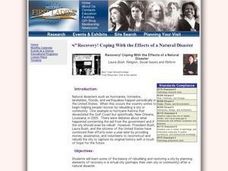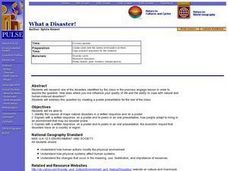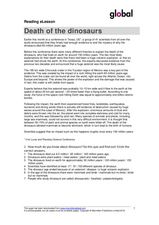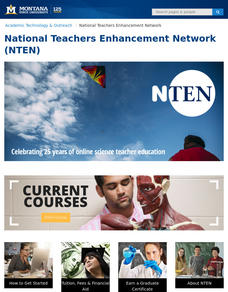Curated OER
Are You Ready to Shake
Young scholars examine earthquakes and tsunamis. In this Earth science lesson plan, students investigate the causes and hazards associated with earthquakes and tsunamis.
National First Ladies' Library
Recovery! Coping with the Effects of a Natural Disaster
Students explore natural disasters and the devastation caused by them. Using specified websites, learners examine how people rebuild after a disaster. In groups, they design and rebuild a community and conclude by writing an essay...
Curated OER
OCEAN TSUNAMI
Students research the concept of a tsunami in detail and the implications of its effect upon a seashore is considered. The causes of a tsunami are investigated and compared with each other.
Curated OER
What a Disaster!
Students identify the causes of major natural disasters in a written response and on a poster. They explain with a written response, on a poster and to peers in an oral presentation, how people adapt to living in an environment that may...
K12 Reader
Earthquakes: Movement of the Earth's Crust
Readers use context to determine the meaning of words found in a short article about earthquakes and the movement of the earth's crust.
Curated OER
Sculptors of the Earth
Students observe evidence of erosion and various rock formations that have formed as a result of erosion and weathering. Their task is to explain how the forces of weathering and erosion contributed to sculpturing these rocks into arches...
Curated OER
The Great Depression and New Deal
Elementary pupils are introduced to the Great Depression as a critical period of hardship in United States history. They engage in collaborative assignments researching the Dust Bowl, the New Deal, US presidents, and presidential libraries.
Curated OER
Bhutan, the Last Shangri-La: Sandwich Squash: How the Himalayas Were Formed
Pupils create and record a model of mountain formation. They identify major mountain building formations. Students understand how the Himalaya Mountains were formed, why they are located near Bhutan, and why they are becoming larger.
Curated OER
Earthquake
Pupils view a video and conduct a problem solving activity to explain the effect different waves have on the earth's structure and what effect they have on different structures.
Curated OER
Tsunami
Students explore tsunami through various hands-on activities. In this earth science lesson, students explain how they are formed. They create tsunami and earthquake models in the lab to observe how they are generated.
Curated OER
Erosion Deposition Review
In this erosion deposition worksheet, students fill in 36 blanks to complete sentences about the formation of soil, the forces of erosion, physical and chemical weathering, sediments and soil deposition.
Curated OER
Extreme Weather
Students examine different types of extreme weather and how to prepare for them. In this weather lesson students explore different types of extreme weather and create disaster preparation posters for different types of extreme weather.
Curated OER
Earthquake Activity
Students design and build a vehicle using Lego. In this earth science activity, students analyze the factors they need to consider when building their vehicles. They present their finished project in class.
Curated OER
Tsunamis by the Book
Learners use the Internet and other sources to investigate tsunamis. They construct books listing several tsunami facts and cite their sources. They read their books to another class.
Curated OER
Death of the Dinosaurs
For this reading comprehension worksheet, students read a 6-paragraph article regarding dinosaur extinction and respond to 5 short answer questions. Vocabulary words and definitions are included.
Curated OER
Demonstrating Erosion in Action
Students easure and record volume of water, then measure and record mass of soil. They explain the effects of the following in controlling erosion: Contouring, cover crop, strip cropping, reforestation, inter-seeding.
Curated OER
Crossword
In this crossword worksheet that focuses on natural disasters, students find the vertical word in the colored squares by filling in the right words in ten lines in the horizontal boxes. Answers appear at the bottom of the worksheet.
Curated OER
The Effects of Volcanoes
Learners use the internet to research the effects of volcanoes. They create a chart showing the negative and positive aspects that a volcanoe can bring to an area. Using PowerPoint, they create a presentation showing the negative and...
PBS
Pbs Learning Media: Global Landslide Catalog
Landslides cause between 1-2 billion dollars in damage per year in the U.S. alone. NASA tracks landslides globally in order to analyze trends in landslide frequency, distribution, and impacts to help scientists better predict landslides...
PBS
Pbs Learning Media: Landslide Animation
There has been 5,741 recorded rainfall triggered landslides worldwide between 2007-2013. Watch this animation by NASA that shows how rainfall over a slope causes ground saturation that triggers a landslide. Also, examine an annotated...
Other
National Resources Canada: Landslides and Snow Avalanches
Defines a landslide, avalanche, and a rockslide and provides examples. Describes the causes and effects of these events.
Science Education Resource Center at Carleton College
Serc: Case Study: Zhouqu, China Landslide
This is a 'citizen science' research project where students to apply their knowledge of landslide processes in an investigation of the natural and anthropogenic causes of a real-world landslide catastrophe. Students produce a 'magazine'...
US Geological Survey
U.s. Geological Survey: Landslide Danger in the San Francisco Bay Area
Download a movie about the 1982 landslides of the San Fransisco Bay Area. Shows many devastating stories, scientific discoveries, and the destruction the landslides caused. [58:27]
Mocomi & Anibrain Digital Technologies
Mocomi: What Is a Landslide and How Does It Happen?
Learn about landslides, their causes, the different types, how to prevent them, names of major landslides, and other interesting facts.




















